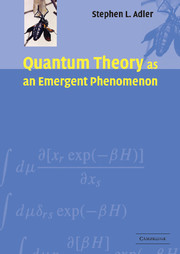 Quantum Theory as an Emergent Phenomenon
Quantum Theory as an Emergent Phenomenon Book contents
- Frontmatter
- Contents
- Acknowledgements
- Introduction and overview
- 1 Trace dynamics: the classical Lagrangian and Hamiltonian dynamics of matrix models
- 2 Additional generic conserved quantities
- 3 Trace dynamics models with global supersymmetry
- 4 Statistical mechanics of matrix models
- 5 The emergence of quantum field dynamics
- 6 Brownian motion corrections to Schrödinger dynamics and the emergence of the probability interpretation
- 7 Discussion and outlook
- Appendices
- References
- Index
Appendices
Published online by Cambridge University Press: 17 March 2010
- Frontmatter
- Contents
- Acknowledgements
- Introduction and overview
- 1 Trace dynamics: the classical Lagrangian and Hamiltonian dynamics of matrix models
- 2 Additional generic conserved quantities
- 3 Trace dynamics models with global supersymmetry
- 4 Statistical mechanics of matrix models
- 5 The emergence of quantum field dynamics
- 6 Brownian motion corrections to Schrödinger dynamics and the emergence of the probability interpretation
- 7 Discussion and outlook
- Appendices
- References
- Index
Summary
To keep the discussion of this book self-contained, a number of topics that are briefly mentioned in the text are treated in more detail in the appendices that follow.
The notation of the appendices follows that generally used in the text. Throughout this book, we indicate sums explicitly, except that the usual Einstein summation convention is used for sums over Greek letter four-vector and tensor indices, and a summation convention is used for the indices i, j in Section 3.3. Our Minkowski metric convention is ημν = diag(1, 1, 1, –1), and we have taken the velocity of light to be unity, so that c does not appear in the equations. However, Planck's constant is generally retained (except in the formulas of Sections 1.5 and 6.3 through 6.5 where we set = 1), because our approach implies that it has a dynamical origin.
Fermionic quantities are represented throughout by Grassmann numbers. Real Grassmann numbers are constructed as products of a basis Xr of real Grassmann elements, that obey the anticommutative algebra {Xr, Xs} = 0 for all r, s, which implies that the square of any Grassmann element vanishes. Complex Grassmann numbers have real and imaginary parts that are real Grassmann numbers. A product of an even number of Grassmann basis elements, multiplied by a complex number coefficient, is called even grade or bosonic, and a product of an odd number of Grassmann basis elements, with a complex number coefficient, is called odd grade or fermionic. Grassmann integration is defined by and so is effectively the same as differention from the left.
- Type
- Chapter
- Information
- Quantum Theory as an Emergent PhenomenonThe Statistical Mechanics of Matrix Models as the Precursor of Quantum Field Theory, pp. 193 - 211Publisher: Cambridge University PressPrint publication year: 2004


